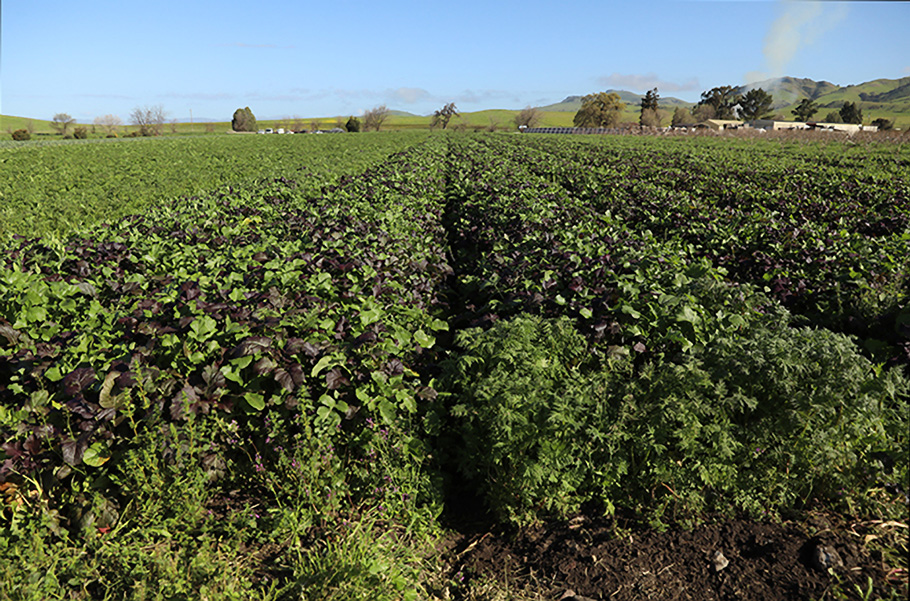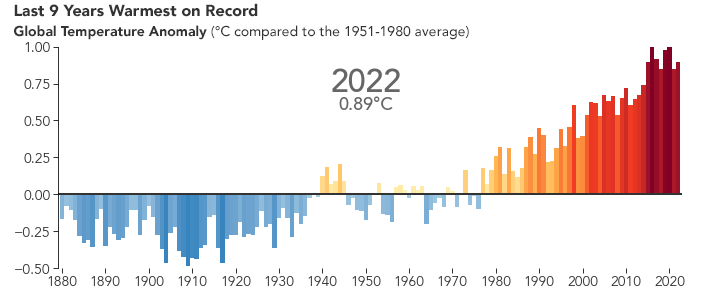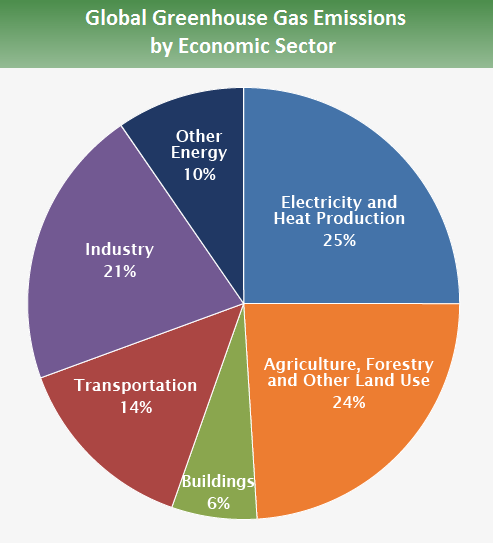
How Regenerative Agriculture Helps Address Climate Change
by CRARS staff member Sheryl Karas. M.A.

Regenerative Agriculture is increasingly cited as a potential key solution to the climate crisis either by reducing its severity by reversing the conditions driving it, by helping the world be more resilient in the face of it, or both. What is less understood by most people is how this could be true. Let’s break it down.
Climate Change
First, it is rarely spoken of but needs to be understood that the climate has always gone through long cycles of cooling and warming for eons. Sometimes there are dips in temperature caused by events like volcanos and other events that cause significant fluctuations; but, generally, scientists believe changes typically happen slowly over thousands of years. In the 1800s the earth seemed to be in a mild cooling period. But recently, as you can see in the chart below provided by NASA, there have been very significant changes and those changes have dramatically accelerated since 1980.

https://earthobservatory.nasa.gov/world-of-change/global-temperatures
Temperatures were recorded before 1880 but until then it wasn’t possible to track global temperature completely so that is why the chart above starts there. Since then, however, several entities have been recording this information and the numbers are very much in sync. On their website NASA explains that global temperature is a reflection of how much energy the planet receives from the sun and how much it radiates back into space. The energy coming from the sun doesn’t usually change very much from year to year, but the amount of energy radiated by Earth is closely related to the amount of heat-trapping greenhouse gases accumulated in the atmosphere. As you can see in the graph, something significant started to change in the late 1930s and 1940s and then increasing again and quite rapidly starting at the end of the 1970s. The last decade has been the hottest in recorded history.
The reason there is cause for concern is that it takes quite a lot of extra heat to warm the planet enough to cause a global temperature shift of even a small amount. The globe has only increased in temperature by about 2º F since 1880 but that is a large increase from a planetary perspective and represents a very significant amount of heat that has been accumulating. That is causing extreme weather events and an increase in chaotic weather patterns such as long periods of drought followed by heavy rain and more intense damaging storms.
 There are several factors converging that seem to be leading to these results:
There are several factors converging that seem to be leading to these results:
- Population growth.
- Acceleration of the industrial economy after World War II (more factories, more pollution).
- Fossil fuel use (increasing about 5% per year since World War II for use in industry, heat and electricity production, transportation, etc.).
- Intensification of farming and agriculture to produce more meat and crops
- Cutting down forests and clearing land to make more room for crops and grazing.
Factors that are specific to farming include release of greenhouse gasses (carbon, nitrogen and methane) into the atmosphere via modern farming practices, land clearing, and use of fossil fuels to run equipment and to transport goods across the country and around the globe. When all these factors are taken into consideration, agriculture, forestry, and other land use contributes about 24% of all annual greenhouse gas emissions. Industrial use, energy production, and transportation are the other most significant contributors.
Source: IPCC (2014); Exit based on global emissions from 2010. Details about the sources included in these estimates can be found in the Contribution of Working Group III to the Fifth Assessment Report of the Intergovernmental Panel on Climate Change.
Conventional Agriculture
A combination of factors led to major changes in agriculture in the early to mid-20th century. More people were moving to the cities to work in factories so there was a need for farmers to produce more food than they used to produce just for their families and small local communities. At the same time, there were significant innovations that made that easier. The invention of the internal combustion engine enabled farmers to use tractors instead of animals to plow and help plant their fields. By 1970 the tractor had replaced animal labor and mechanized harvesting of many crops had become the norm. During the Dust Bowl it became clear that the land is some parts of the country had become too degraded to farm, but the invention of chemical fertilizers and mechanical irrigation changed that. Modern farmers were encouraged to use those cutting edge tools to run their farms because it led to much greater yields. It was also thought that using the mindset that made industry work so successfully would be best in farming as well: choosing what seemed like the most efficient ways to get the most yield for the least effort. Paying attention to the three chemicals that seemed to have the highest impact on yield (nitrogen, phosphorus and potassium or NPK fertilizer) fueled the growth of input-intensive agriculture. Monoculture planting of new hybrid crops also came out of this mindset and almost completely replaced diverse farms that used to produce multiple kinds of crops and animals for food. That also led to the need for pesticides and herbicides as the natural biology of the land was no longer being supported by “old-fashioned” practices.
Farmers were highly rewarded for these choices. Those who participated not only saw higher yields and higher profits, they were lauded for contributing to the “Green Revolution” and saving millions of people from starvation. Some of the drivers of this approach still exist—global population is still increasing—but food waste has skyrocketed. According to the FDA(opens in new window), 30-40% of the food supply in the United States is wasted, approximately 133 billion pounds of food. And waste is not confined to the United States. Globally, estimates of food waste(opens in new window) run to about 17% with the most waste happening in China and India (the U.S. is third). Food waste itself is a driver of climate change—contributing 8-10% of global greenhouse gas emissions.
Meanwhile, the shift in how food has been produced in the last century represents a dramatic shift in environmental impact. We already know that excessive tilling, land-clearing, and leaving the land uncovered between seasons coupled with drought and unusually high temperatures most likely created the conditions for the Dust Bowl to occur. These practices also release more carbon back into the atmosphere than methods that focus more on soil conservation and habitat preservation. Synthetic fertilizer, mechanization, and irrigation were a great temporary solution for growing food with higher yields in order to combat the economic devastation of the Great Depression; but they don’t do a good job of building healthy soil, avoiding soil erosion, and avoiding the release of greenhouse gasses. And with skyrocketing fertilizer prices and an increase in extreme weather events, many farmers find themselves struggling in a profession that has already been rocked by reduced commodity food prices, pandemic supply chain problems, global trade wars, and other factors. Farming and ranching has one of the highest suicide rates of all occupations in the country.
Because some well-known regenerative farmers like Gabe Brown talk about their success in saving the family farm by switching to these methods, many farmers and ranchers are starting to look at regenerative agriculture as a potential solution. That might turn out to be good for combating climate change as well.
Regenerative Agriculture
Regenerative Agriculture focusses on regenerating the health of the soil and working with natural processes to restore balance to both the ecosystem of the farm and of the planet. When ecosystems are working well, excess carbon dioxide is drawn down from the atmosphere (where it acts as a heat-trapping greenhouse gas) by plants and trees who use it through the process of photosynthesis to feed themselves and the biology of the soil. Some of that carbon dioxide respires back out but in much of nature, when undisturbed, about half of that carbon is either used by the plant or accumulates in the soil.
Soil biology is an extremely important aspect of how this works. Soil is not just chemically-laden dirt. Healthy soil teems with life: earthworms, insects, fungi and other microbes, and other creatures. In fact, the soil is home to 25% of the earth’s animal species, and 40% of all terrestrial organisms depend on their relationship with the soil (PDF) during some part of their life cycle. Many of these creatures form symbiotic relationships with each other and with plants. Some help supply plant roots with nutrients and water in exchange for carbon combined with hydrogen and oxygen in the form of sugar from the plants. Together they help decompose plant and animal debris which improves nutrient cycling and availability (in particular, nitrogen), improve soil porosity (which helps with water infiltration and retention when it rains), and also bind together soil particles into aggregates that help hold the soil in place and reduce erosion.
Plants grown in healthy soil don’t need added fertilizer. Once the soil is fully restored and maintained the system feeds itself and feeds the plants. But when the biology in the soil is harmed through excessive use of tilling and added chemicals, the soil degrades. Imagine chopped up earthworms and dead fungi. The system cannot renew itself with constant disturbance, and farmers find themselves in the situation of needing to spend more and more money on chemical inputs to stay in the same place (or worse).
It is important to understand that all agriculture sequesters carbon from the atmosphere through photosynthesis, but it is a combination of practices not typically used in conventional agriculture that ensure more carbon is stored than released, and that the drawn down carbon stays underground where it is beneficial. Those practices include
- eliminating or greatly reducing tillage so the soil is disturbed as little as possible
- keeping the soil covered with roots in the ground throughout the year through the use of cover crops, crop rotation, and mulch
- maintaining or adding permanent plantings through the use of silvopasture, hedgerows and pollinator habitat
- increasing biodiversity through the use of multiple species of plants (perhaps in rotation) and animal integration when possible (which adds natural fertilizer in the form of manure).
Some experts(opens in new window) estimate that expanding regenerative farming worldwide could remove 15-23 gigatons of CO2 from the atmosphere by 2050. However, recent studies indicate that multiple regenerative practices used together could sequester more carbon at a faster rate than previous expectations. The Carbon Cycle Institute estimates that farms and ranches could sequester over 60 million metric tons of carbon annually by 2030 in California alone. That would more than offset the agricultural sector’s climate emission impact. This, of course, depends on these practices being maintained, but when farmers and ranchers take the time to learn what works on their land and in their climate, they rarely go back. Success leads people forward.
